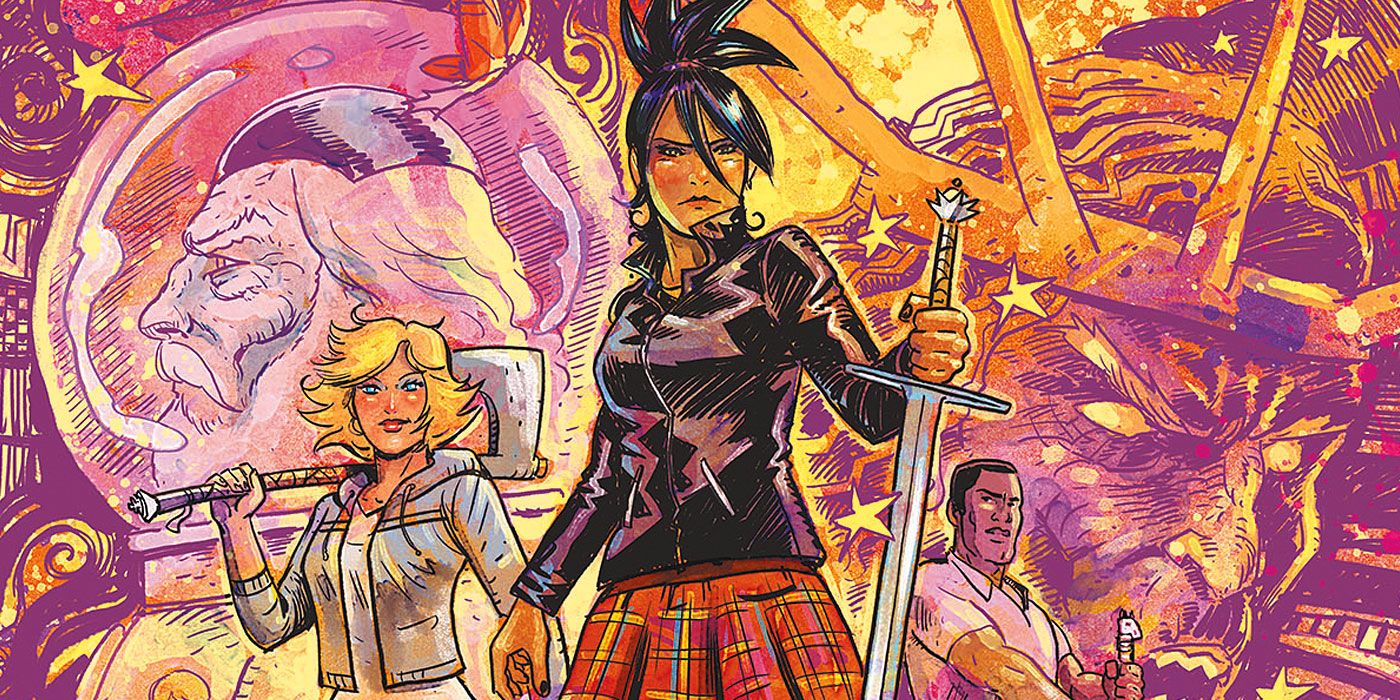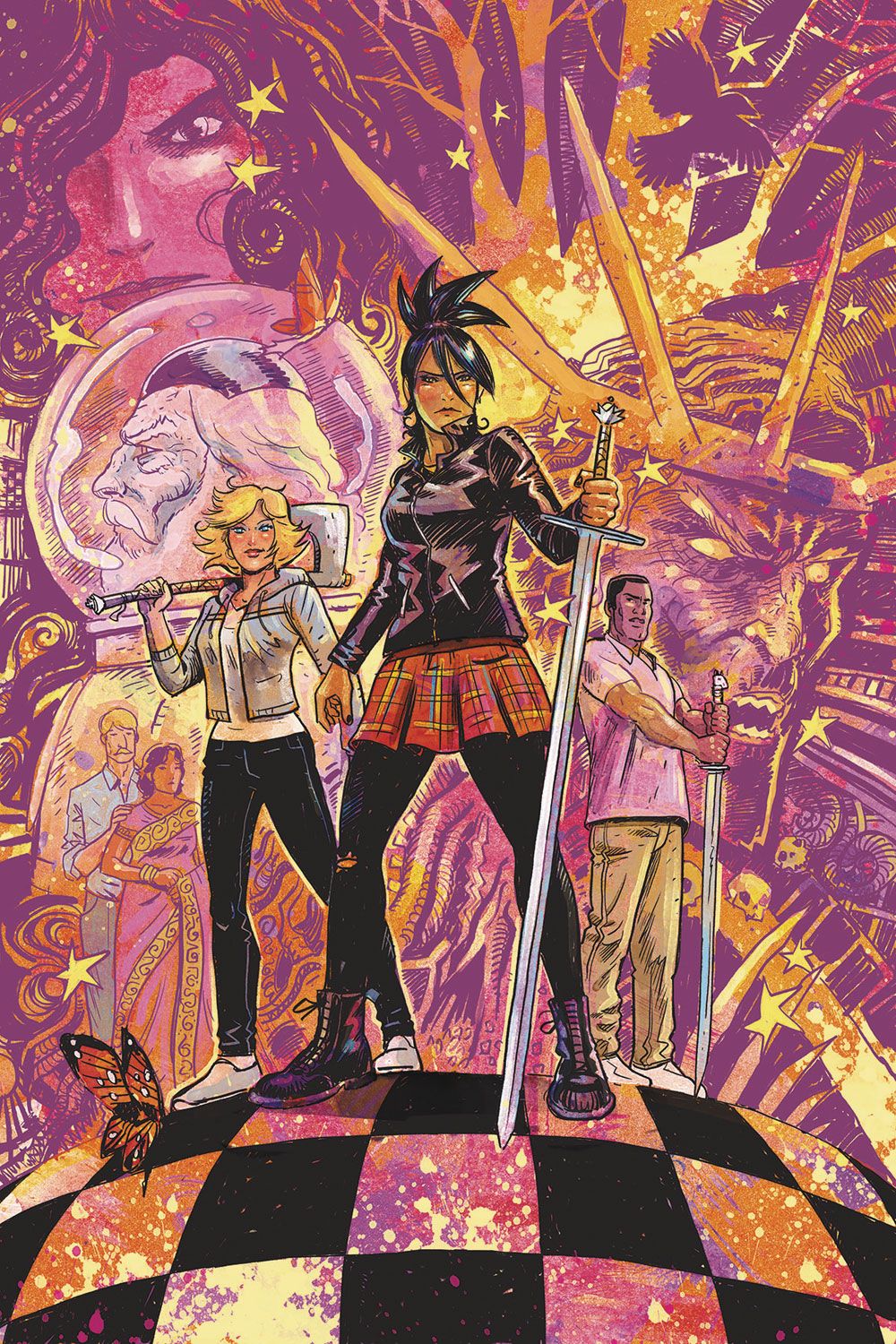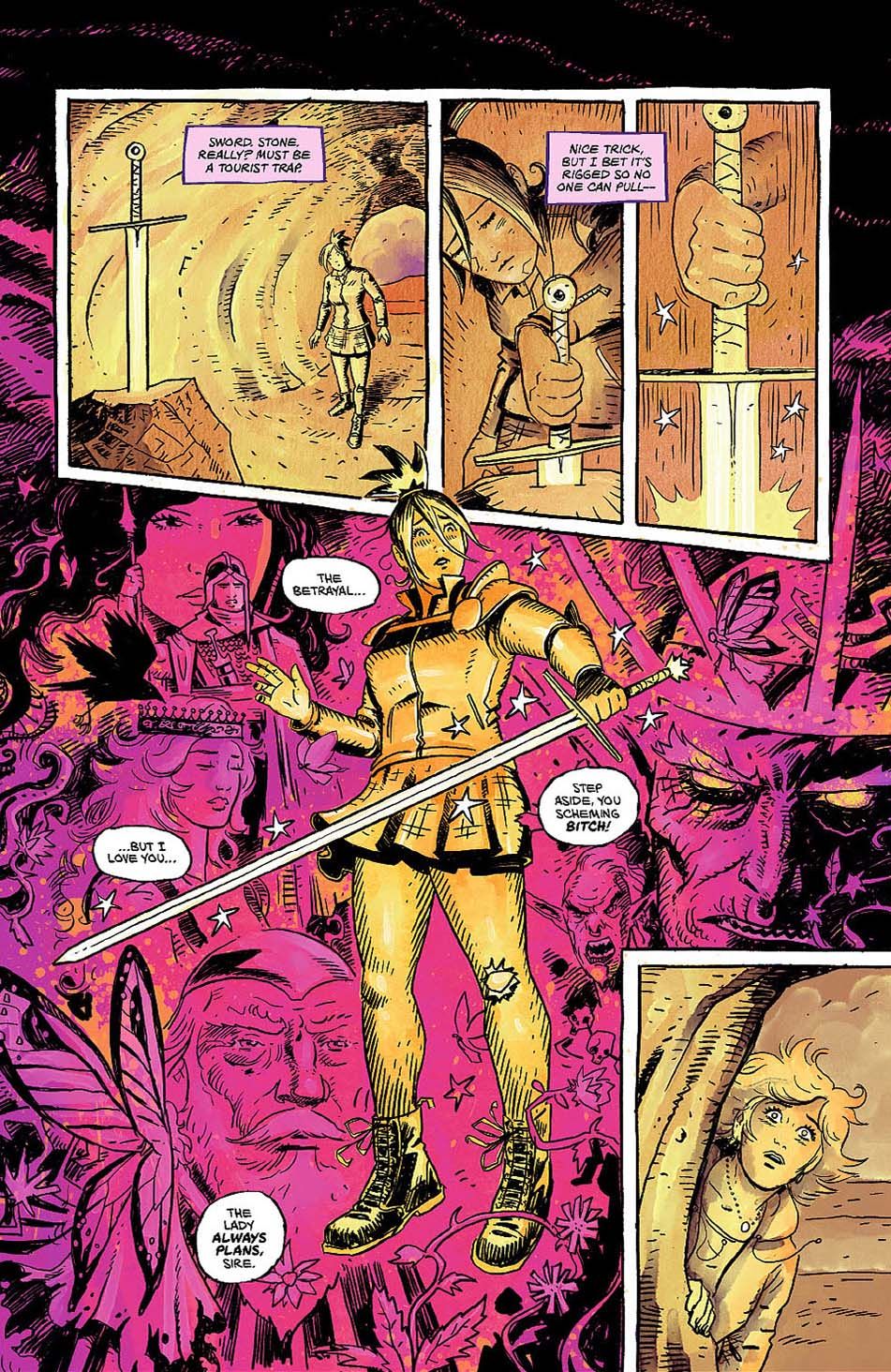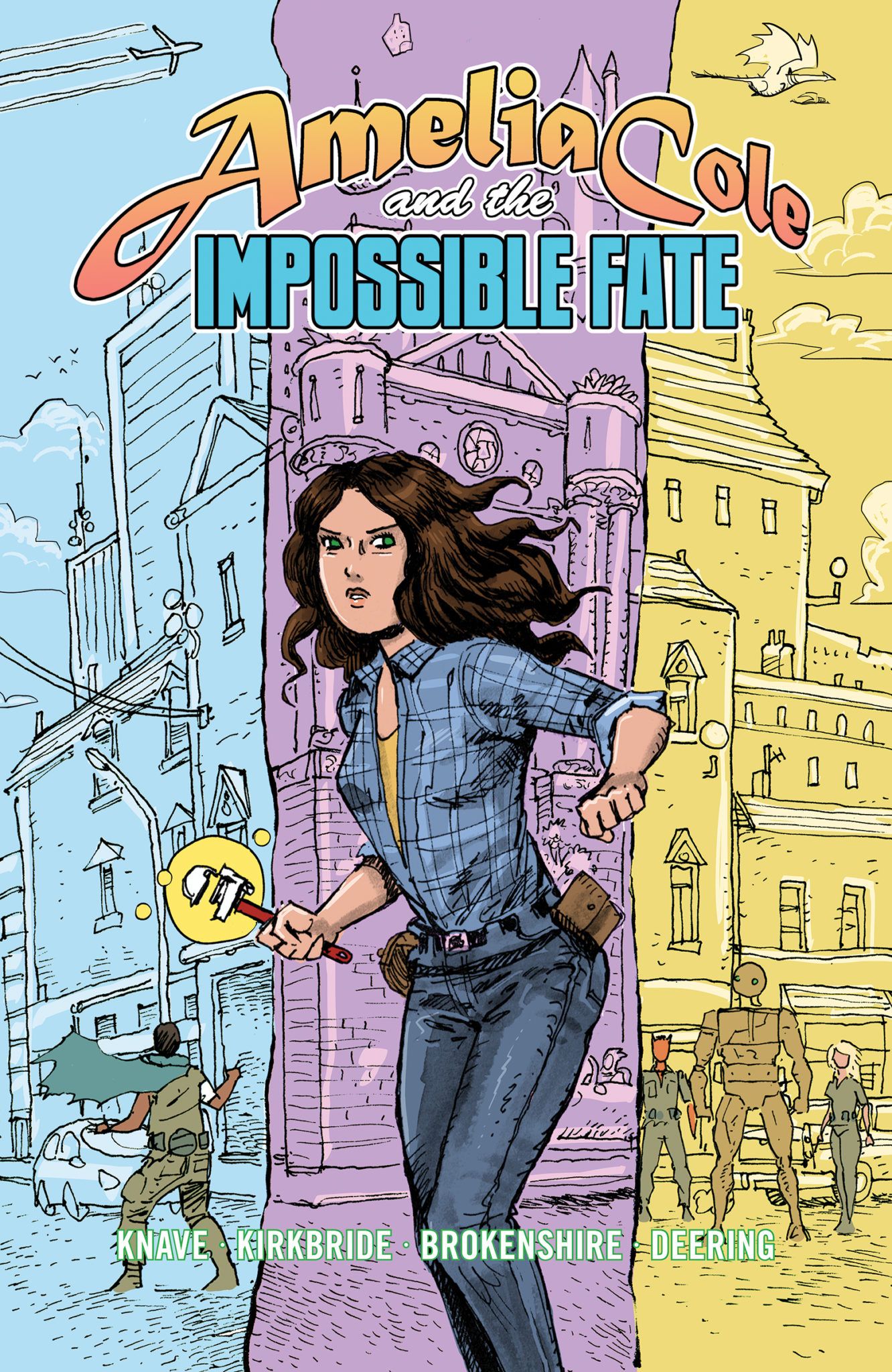With their now-concluded ongoing Monkeybrain Comics series "Amelia Cole," the team of D.J. Kirkbride, Adam P. Knave and Nick Brokenshire literally took a wrench to the concept of magic and mysticism, in the process creating one of the publisher's most beloved and acclaimed comics. This year, however, the team have reformed for a new series - and this time they're swinging from the hilt, sword in hand.
"The Once and Future Queen" is a re-imagining of the legend of King Arthur, but sees the sword in the stone pulled by Rani Arturus, a teenage girl living in the modern day who travels to England to participate in a chess tournament. Having somehow ended up pulling out a mythical sword which entitles her to reign as Queen, Rani has to deal not only with all that brings - but also the arrival of Merlin, magic, and a whole mess of trouble coming directly for her.
As pencilled by Brokenshire, this looks to be a classically madcap take on the legend of Arthur. CBR spoke with the creative team about everything they have planned for their new series at Dark Horse. Also, we spoke about "Silverhawks" for some reason.
CBR: How important was it for you all to be involved in this one - to have Frank, Nick, Adam and D.J. all working together again?
Nick Brokenshire: I feel that we communicate very easily. And after having played in the all ages sandbox, I wanted to see what we as a team could do with something a bit meatier. Also, I was ready to try some different things with the art and figured the lads would trust me enough to do it... I hoped they would, and they did.
D.J. Kirkbride: Nick, Adam, and I learned so much over the course of 30 issues of "Amelia Cole," not only in terms of working together, but of making comics in general. Adam and I have also done several books with Frank, together and separately, and we knew he'd work well with Nick, too. This is our dream team here.
Adam P. Knave: We all work with other people, and other teams and we enjoy that too, but you get a certain creative matrix going and you can just lean in. It's like, remember that old cartoon "Silverhawks?" You had all those dudes who were fighting crime in space and what-not, all silvery and decked out with fancy wings that somehow worked in space and all. And sure, they could fight crime apart, but when they're together, well then you really get a sense of "Man you guys need to stop coordinating your outfits quite so much and why does that one guy have a bandana and cowboy hat anyway?" it's like that with us. Except in all the ways it's different.
Kirkbride: The bandana and cowboy hat is applicable to our team, too, though. It's about style, Adam.
Knave: Oh, right, good point.
How does the collaborative process work between you after your long run on "Amelia Cole"? Do you find that you can almost work shorthand with one another now?
Brokenshire: It feels very similar but with wondrous added sparkle of our editor, Shantel LaRocque, keeping us straight and giving course correction. It's very pleasant, from my perspective. I like working with the chaps and they pity me enough to give me stories to draw.
Kirkbride: It's great to have her editorial perspective. She's very involved in an encouraging way. In terms of the writing, Adam and I always want to impress Nick first, so if he's excited to draw, we know we've got something potentially good on our hands. We live to impress that guy. Maybe it's his cool Scottish accent...and the fact that he can write, too...and draw...and, c'mon, he's an awesome musician, too! All that talent in one person is unfair, frankly. Oh, speaking of, Frank also chimes in with his take on some of the story elements, which has been invaluable. He saved our butts recently.
Knave: Look at these guys giving you smart simple answers. This is why they keep making me answer last, Steve. This. Is. Why. Because I'll give you the truth they fear! They fear as if Mon*Star and his mob were after them. No, wait, never mind. But yeah, we admit, there is a level of shorthand that creeps in on any group working together for long enough. We all built these characters together so D.J. and I can type "Rani's mad" and Nick knows what that means from a body language perspective and how it shapes a panel in ways we might have to use twenty words with for someone else.
We also just have a huge amount of trust in each other at this point. So there can be notes telling Nick to go a bit nuts, and we'll leave him alone for certain scenes and when we get ultra-specific he trusts we're not doing it to annoy him and he can see the reasons behind our choices. Also knowing Nick's approach so well lets us craft pages specifically to him in even deeper ways.
If "Amelia Cole" was for all-ages, then "The Once and Future Queen" aims at telling a YA story. What is it that you find so interesting about writing into that demographic, and changing up your approach and audience?
Knave: One of my biggest personal challenges on "Amelia Cole" was the language use. I curse. A lot. Like, too much, probably. It's an issue. Frankly, I wasn't raised right. So I had to rein all that in super tight for years. Now we can use some good ol' light PG-13 cussin' and it makes me happy. But also thematically, pushing this up to YA from all-ages allows us to explore more mature themes, in the real sense, not just "Adam like to curse" sense. It's not that the story is darker (though it can be at times, a lot of them) but there is a different perspective at play here, a more adult one. You'll see it in relationships, in actions, and choices made.
Kirkbride: When we were starting "Amelia Cole", our goal was to make a truly "all-ages" comic. Not a "kid's" book. They're often awesome, but kids seem to always want to read up. We wanted it to be like a kid watching Star Wars with her folks, for example. Everyone's enjoying it, not just the youngster. For "The Once and Future Queen", one of our goals was to age up in part so that Nick could stretch his artistic style while Adam and I challenged ourselves to dig into some deeper themes, but also in the hopes that if a reader grew up a little reading "Amelia Cole" over its four year run, they'd be ready to follow us onto something that skewed a little older.
And now Adam gets to use type the "s-word" and whatnot in scripts. It makes him happy, and that's all any of us really want. That, and pizza.
What was it that first interested you all in taking Arthurian mythology and redefining it within the series?
Knave: I have always wanted to work on an Arthurian story. I had outlines of novels dealing with it, I read a bunch of it, it's a capital-T Thing for me. And yet, until D.J. mentioned going there for the story I hadn't thought of doing it with this approach. Which thrills my cold, dead, heart.
Brokenshire: For me, Arthurian Legend is in my creative DNA. Also The Brokenshire's have a deep connection to Cornwall (among other places) so it's very groovy for me to tell this tale. I read "Le Morte D'Arthur" when I was 16 and Boorman's "Excalibur" is in my top 10 movies.
Kirkbride: Everyone knows of the legend, even if it's in a tangential sense. Even if you've never read the stories or T.H. White's "The Once and Future King", there's Disney's "The Sword in the Stone" and the fact that "Star Trek" has a very round table feel to it. It's in our collective consciousness.
How do you keep that connection to old-time myth but take a story like this into a contemporary, modern-day setting?
Brokenshire: I grew up in a very magical place in Scotland called The Hill Of Fare in Aberdeenshire, where fairies and goblins and all manner of creatures dwell. I would walk through the forest with my dog in he middle of the night singing and inventing nonsense. I draw upon that part of my life. As for the contemporary, I personally have a few people in mind when I draw these characters and I try to infuse as much of their personality into what I'm doing. Hopefully that gives them some contemporary realism... I hope it does!
Knave: Myths are about people. We're still people. The point of the myths, a lot of what they dealt with, are still relevant just in new and strange ways. So the trick was always to find the threads and pull them forward, and then snap them off, twist and tangle them and get something new out of them. Something that wasn't "Silverhawks," because this could have been a "Silverhawks" book if we did everything totally differently and… good lord why can't I stop thinking about that dumb old TV show today? I apologize, on behalf of myself and my ancestors. And Lt. Colonel Bluegrass.
"Silverhawks" aside for the moment, who is Rani, your lead character? What kind of a person is she, and what are her goals, ambitions, motivations?
Kirkbride: Rani's a pretty serious and very intelligent person. She has an analytical mind and goes with her gut less than, say, Amelia Cole. Amelia was super "leap before looking," especially at the start of the series. Rani likes to plan. We join her at a crossroads in her life as she pursues her passion for chess without a clear goal of what to do for her future. She's taking a break before college, though that's presumably the next step. Then we throw a spanner in the works with all this crazy Excalibur stuff, and while it's terrifying and totally unexpected, it might help her reach her true potential.
Knave: And it might not, to be honest. Life is never a straight line and it's always messy, and Rani always loved structure and held it close. Shifting isn't easy for any of us, and with the pressure she's under, well, it doesn't always end well.
Kirkbride: So, to recap, we're probably ruining Rani's fictional life.
Knave: Which is, in fact, our job. Right? Not to say she doesn't get big happy bits, too. She does.
There’s a chess motif running through the series, with Rani herself a chess prodigy. Is this story all about the Queen, then, or can we expect a full ensemble piece here?
Knave: This is a big ensemble piece with a central character to pin it in place. Like the original Star Trek, really. Sure Kirk was the main character and the story often revolved around him, but Spock and McCoy, and the whole bridge crew really, were fully formed characters and had important things to do and say, pushing story in different directions that if it had been The Captain Kirk show. The Queen might call the shots, for the most part, but any good leader knows you listen to the people around you and make them count. Even a pawn can be crucial, after all.
Kirkbride: I'm more of a checkers guy, so whatever Adam said is probably right. King me.
How did you approach the design of the characters? Nick, were you working from any particular inspiration or theme, here?
Brokenshire: I made it my aim to make these characters visually far more realistic than the Amelia Cole characters. Like I said, I do have certain people in mind as basic character templates for everyone. No-one famous, just people I know. Rani is something of an amalgam. The other major thing that I've done is create very specific wardrobes for the characters and I will literally don their clothes (or the closest thing I can find) and take reference pictures for almost every panel. I've paid attention to inventing body movements and postures that are particular to each character. I have folders full of me posing as the characters trying to find their style.
Clothes-wise, we decided early on that Rani would be something of a punk-rock girl so that's quite a specific style. Gwen is a funny mixture, she's totally badass but likes to wear powder blue and pink. Lance is a maker of things so he's practical in his attire. The Fae, they are a mix of traditional Fairy, Uruk Hai and something more contemporary. I think about this stuff non-stop. I could go on!
Kirkbride: Nick's attention to detail here really shows. Sometimes it's tough in comics to tell characters apart if they don't have fancy costumes (Bruce Wayne and Clark Kent used to be visually pretty interchangeable, for instance.), but Nick's given them all unique faces and body types and poses. It makes the visual storytelling more sophisticated, and it gives Adam and me the ability to get into some more subtleties in the writing.
Of course, though…. the story of Arthur is a tragedy, filled with villainy, betrayal, and torment. What sort of surprises can we expect from your story as it develops across the coming months?
Brokenshire: Jousting, Magic Rocks, Monsters, Bloodshed and a dash of "Dawson's Creek". Is that fair to say, boys?
Kirkbride: That sounds about right. While we're using Arthurian Legend as a starting point, this is very much its own story. Some of the surprises and excitement will come in little twists to the familiar tropes, but it's really its own thing. Our goal was to surprise each other when creating it. Part of the fun of doing an indie book with a publisher as encouraging as Dark Horse and an editor as open as Shantel is that no idea is too "out there"--at least not yet. She hasn't read the script for issue 5 yet.
Knave: All I can really say is, to people who are familiar with our work on "Amelia Cole" - we planted stuff in issue one that didn't pay off until the last arc. We build deep, and leave a ton of space to shift around our own plans and still land where we mean to. So there's a lot going on under the surface here.
Issue #1 of "The Once and Future Queen" arrives March 1, 2017.




